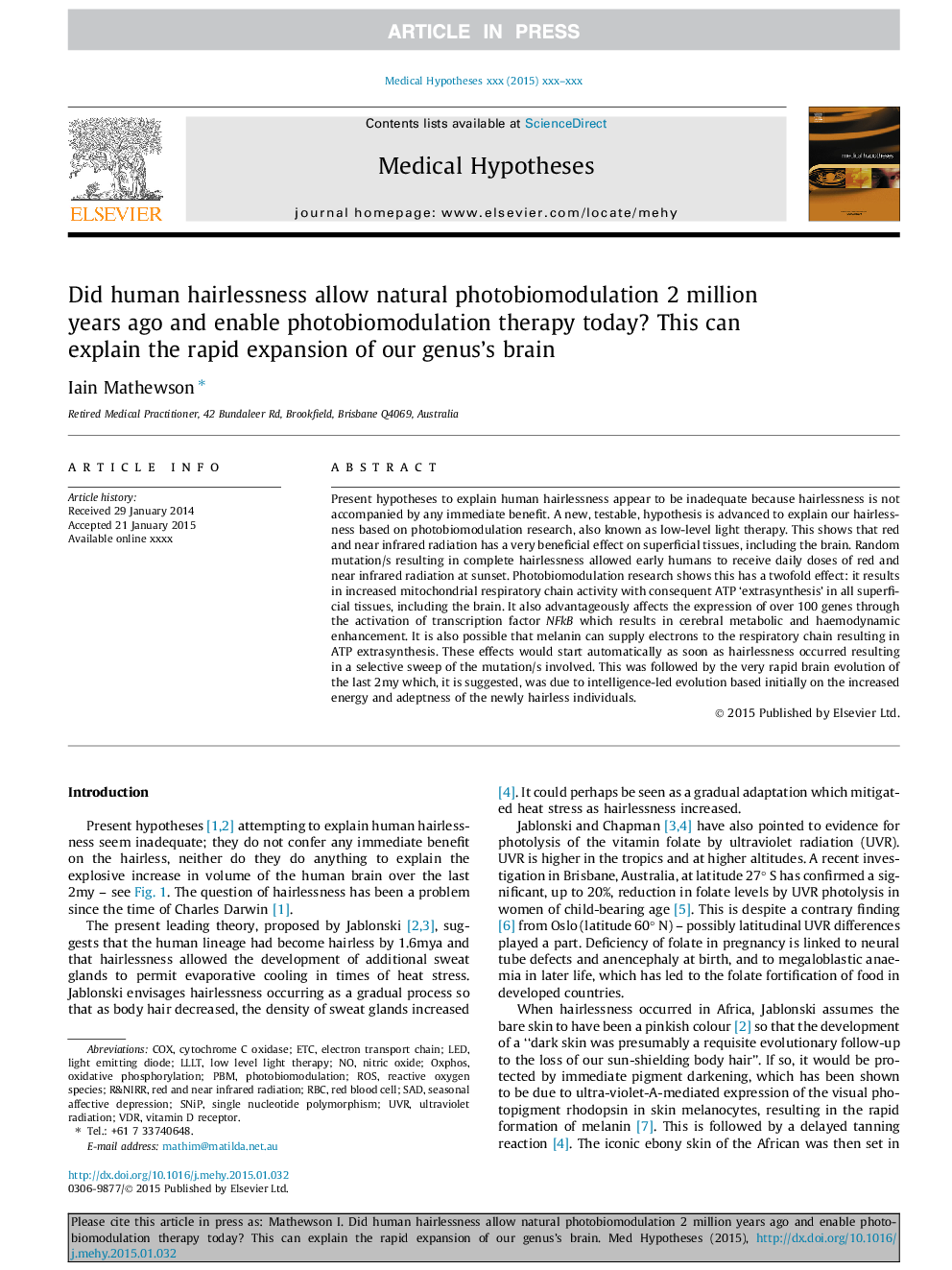| کد مقاله | کد نشریه | سال انتشار | مقاله انگلیسی | نسخه تمام متن |
|---|---|---|---|---|
| 5811367 | 1115010 | 2015 | 8 صفحه PDF | دانلود رایگان |
عنوان انگلیسی مقاله ISI
Did human hairlessness allow natural photobiomodulation 2 million years ago and enable photobiomodulation therapy today? This can explain the rapid expansion of our genus's brain
ترجمه فارسی عنوان
آیا بی مویز انسان اجازه می دهد 2 میلیون سال پیش فتوتراپی طبیعی ایجاد کند و امروزه درمان فتوتراپی را فعال کند؟ این می تواند گسترش سریع مغز جنس ما را توضیح دهد
دانلود مقاله + سفارش ترجمه
دانلود مقاله ISI انگلیسی
رایگان برای ایرانیان
کلمات کلیدی
COXLow level light therapyPBMLLLTSNIPOXPHOSVDRRBCUVRROS - ROSUltraviolet radiation - اشعه ماوراء بنفشLight emitting diode - دیود ساطع نورLED - رهبریelectron transport chain - زنجیره انتقال الکترونcytochrome c oxidase - سیتوکروم سی اکسیدازSAD - غمگینOxidative phosphorylation - فسفوریلاسیون اکسیداتیوPhotobiomodulation - فوتو بیوژنیNitric oxide - نیتریک اکسیدETc - و غیرهSingle nucleotide polymorphism - پلیمورفیسم تک نوکلئوتیدیred blood cell - گلبول قرمز، اریتروسیتReactive oxygen species - گونههای فعال اکسیژنVitamin D receptor - گیرنده ویتامین D
موضوعات مرتبط
علوم زیستی و بیوفناوری
بیوشیمی، ژنتیک و زیست شناسی مولکولی
زیست شناسی تکاملی
چکیده انگلیسی
Present hypotheses to explain human hairlessness appear to be inadequate because hairlessness is not accompanied by any immediate benefit. A new, testable, hypothesis is advanced to explain our hairlessness based on photobiomodulation research, also known as low-level light therapy. This shows that red and near infrared radiation has a very beneficial effect on superficial tissues, including the brain. Random mutation/s resulting in complete hairlessness allowed early humans to receive daily doses of red and near infrared radiation at sunset. Photobiomodulation research shows this has a twofold effect: it results in increased mitochondrial respiratory chain activity with consequent ATP 'extrasynthesis' in all superficial tissues, including the brain. It also advantageously affects the expression of over 100 genes through the activation of transcription factor NFkB which results in cerebral metabolic and haemodynamic enhancement. It is also possible that melanin can supply electrons to the respiratory chain resulting in ATP extrasynthesis. These effects would start automatically as soon as hairlessness occurred resulting in a selective sweep of the mutation/s involved. This was followed by the very rapid brain evolution of the last 2my which, it is suggested, was due to intelligence-led evolution based initially on the increased energy and adeptness of the newly hairless individuals.
ناشر
Database: Elsevier - ScienceDirect (ساینس دایرکت)
Journal: Medical Hypotheses - Volume 84, Issue 5, May 2015, Pages 421-428
Journal: Medical Hypotheses - Volume 84, Issue 5, May 2015, Pages 421-428
نویسندگان
Iain Mathewson,
